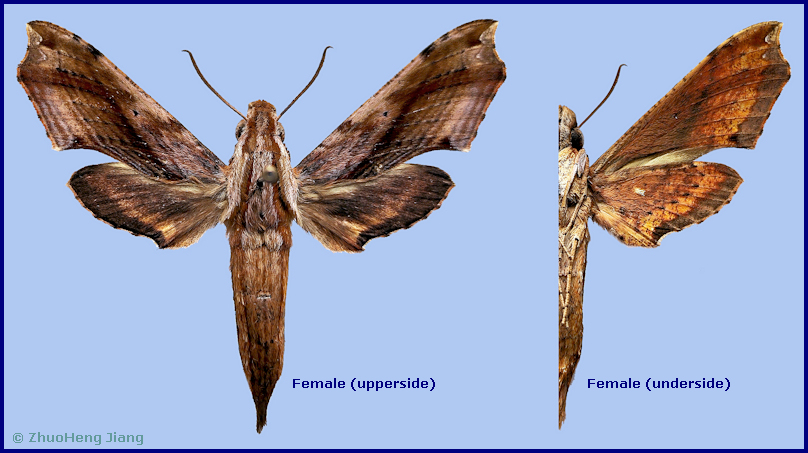
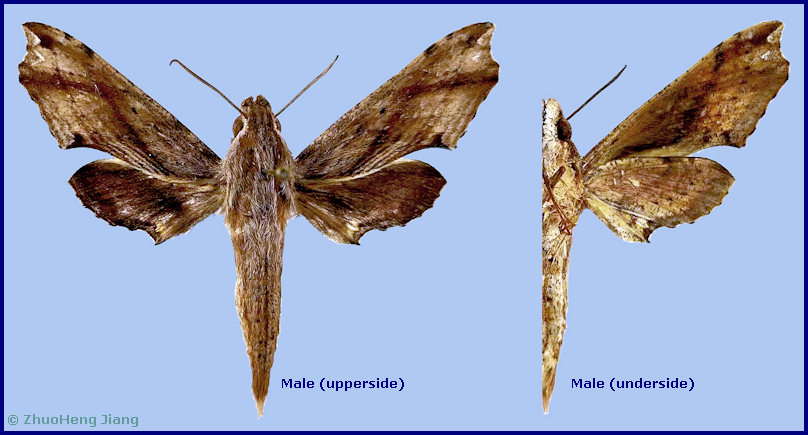
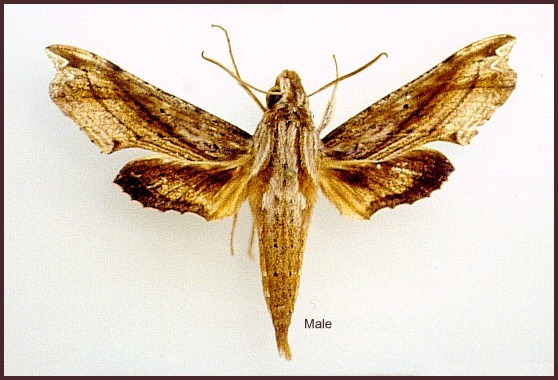
Eupanacra moseri (Gehlen, 1930), Entomologische Zeitschrift, Frankfurt-am-Main, 44: 130. Type locality: [India,] Upper Assam
Synonym. Panacra moseri Gehlen, 1930.
Synonym. Eupanacra waloensis Brechlin, 2000, Nachr. entomol. Ver. Apollo (N.F.) 21: 72. Type locality: China: Yunnan, Nijiang & Dulong Autonomous Prefecture, Fugong County, 42km north of Fugong, Lishadi (= Walo), 27°15'N 98°55'E, 1390m.
Note. Panacra moseri Gehlen, 1930 was described from an unspecified number of males from Upper Assam. Only one male, in very poor condition, has been found in the MNHU. It is this specimen which was designated as the lectotype by Kitching & Cadiou (2000), who also synonymized it with Eupanacra malayana. However, Haxaire & Melichar, 2023, disagreed with this synonymy and revalidated the species as Eupanacra moseri for the following reasons. In comparison with Eupanacra moseri, Eupanacra malayana has shorter, more compact forewings, and is less greyish in colour. In Eupanacra moseri the wing patterns are more subdued, and on the underside of the forewing, the broad, dark postmedial line, a line that is extremely visible on the lectotype and most of the Indian specimens, is lacking. Eupanacra moseri is a more slender insect with a narrower forewing, so that the termen is markedly more concave between veins Rs3 and M2, giving it a more falcate appearance.
Note. Eupanacra waloensis was described from Yunnan, China, from four specimens, which were compared with Eupanacra malayana. As Brechlin already thought that his specimens were distinct from Eupanacra malayana, he did not revisit the synonyms of that species. There is no doubt in the minds of Haxaire & Melichar, 2023, that Eupanacra waloensis is synonymous with Eupanacra moseri based on it's characteristic wing pattern and genital armature. A comparison of the DNA barcodes of the holotype and a paratype of Eupanacra waloensis (BOLD sample id BC-RBP1162) with a series of Eupanacra moseri from India has shown that they are identical (Haxaire & Melichar, 2023).
Similar to Eupanacra malayana but forewing apex more acute and excavation below apex deeper. Forewing upperside similar to Eupanacra malayana but: ground colour pale grey; postmedian lines lacking vein dots; area beyond submarginal line much paler than rest of wing. Forewing underside ground colour sooty-grey, against which the transverse lines are only obscurely visible. Hindwing upperside similar to Eupanacra malayana but median band dirty white (rather than yellowish or reddish-brown), extending into a paler and more extensive area on the inner margin. Upperside of abdomen lacking dorso-lateral longitudinal gold bands.
In the male genitalia, similar to Eupanacra malayana but: uncus broader and apically more sclerotized; gnathos apically bifid (as in Eupanacra malayana) but the points rounded and strongly upcurved; harpe very short, acutely triangular, apically bluntly pointed; phallus apical process right lobe shorter, strongly sclerotized, with three or more apical teeth; left lobe strongly sclerotized, also with three apical teeth; angle between the lobes obtuse and rounded (almost a right-angle in Eupanacra malayana).
With regard to the male genitalia, Gehlen (1930) illustrated only the transverse apical plate of the phallus, but this is nevertheless very characteristic. Haxaire & Melichar, 2023 found the same form in their Indian specimens, which allowed them to separate them from Indonesian Eupanacra malayana. This plate has a wider, more strongly toothed right process, and a more developed left process, which is more strongly toothed basally. The harpe of Eupanacra moseri is also more tapered, less straight, with a blunter tip.
Finally, analysis of DNA barcodes shows an average genetic divergence of 4% between typical Eupanacra malayana from Indonesia (the type locality of Eupanacra malayana) and Eupanacra moseri (Haxaire & Melichar, 2023), which is more than enough to regard them as distinct species.
It should be noted that the holotype of Eupanacra waloensis has atypical genitalia. The illustration in Brechlin (2000: fig. 13) shows surprisingly short harpes, half as short as those of all the specimens determined at the time as Eupanacra waloensis, including a paratype from the same locality that shares the exact same barcode. Haxaire & Melichar, 2023, therefore state that the holotype has an unrepresentative genital structure (Haxaire & Melichar, 2023).
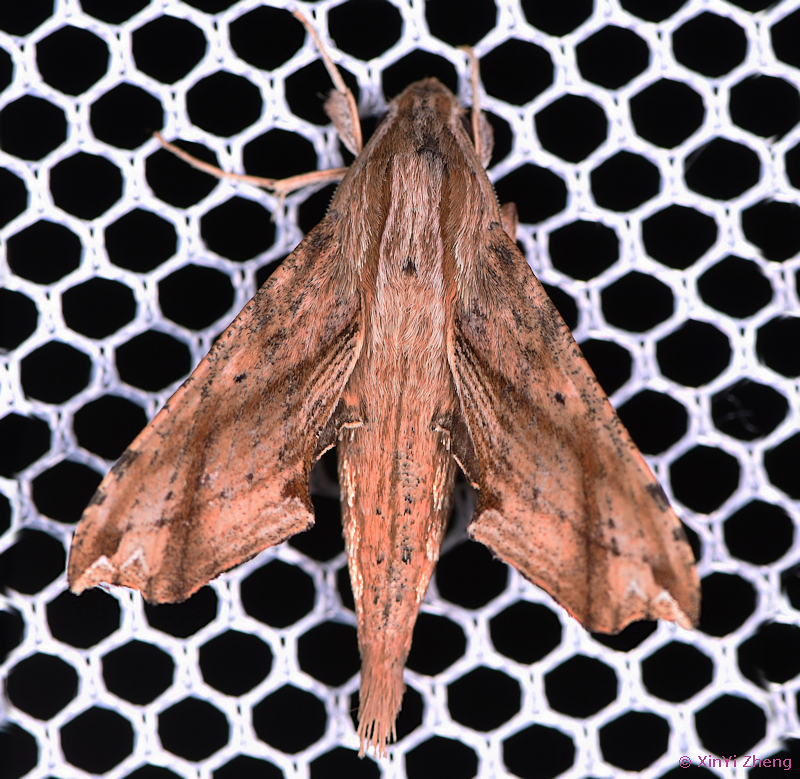
Unknown.
China: iii-iv (Yunnan); vi (Guizhou).
OVUM: Unknown.
LARVA: Unknown.
PUPA: Unknown.
Larval hostplants. Unknown.
Unknown.
China: Yunnan (Walo; Puwen); Guizhou (Fanjingshan, Tongren County); Hainan (Jianfeng Ling).
Northern India (Assam, Arunachal Pradesh, Meghalaya, Mizoram), Bangladesh, China (Yunnan, Guizhou, Hainan), Thailand (Chiang Mai) and, surprisingly, Sabah, Malaysia (Borneo). The Borneo specimen, collected by Haxaire, is a remarkable southern extension of a species originally described from northern India (Haxaire & Melichar, 2023).
[It should be noted that there are now no known Indian or Chinese specimens of Eupanacra malayana. All individuals examined have turned out to be Eupanacra moseri].
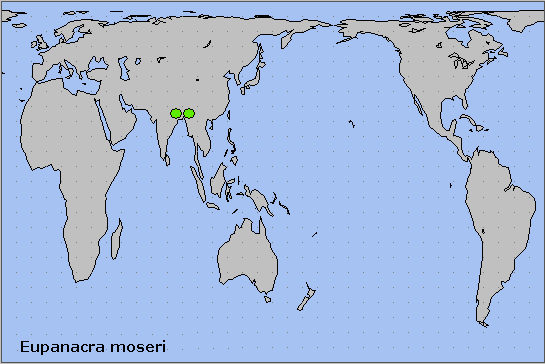
 Return to Sphingidae of the Eastern Palaearctic species list
Return to Sphingidae of the Eastern Palaearctic species list